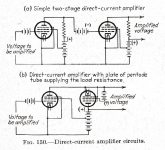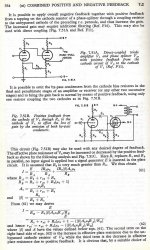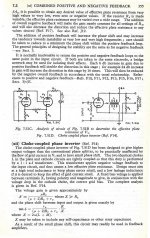I recently got another classic - Fred Terman's* Radio Engineering. I came across a reference to what could be the first documented use of a cascode or SRPP or similar with tubes: The use of a Vacuum Tube as a Plate Feed Impedance by J. M. Morton. It was published by the Franklin Institute vol 216, December 1933.
Posting this in the small chance that someone has a copy and would be willing to share.
Jan
*Professor Frederick Emmons Terman was Bill Hewlett's promotor at the time and later helped him to set up Hewlett & Packard together with Dave Packhard.
Posting this in the small chance that someone has a copy and would be willing to share.
Jan
*Professor Frederick Emmons Terman was Bill Hewlett's promotor at the time and later helped him to set up Hewlett & Packard together with Dave Packhard.
If you are willing to pay 25 dollars for it, you can find it here: https://www.sciencedirect.com/science/article/abs/pii/S0016003233907607 I can't find a paper version of it in the catalogue of the Delft university library, but then again, I have difficulty finding anything with the catalogue they have now.
Many people would say that Fred Emmons Terman is the true father of what is today Silicon Valley.
Several of his students such as Hewlett & Packard started business in the San Fransisco Bay area.
That includes the Varian Brothers.
https://en.wikipedia.org/wiki/Frederick_Terman
But I don't have a copy of that article.🙂
Several of his students such as Hewlett & Packard started business in the San Fransisco Bay area.
That includes the Varian Brothers.
https://en.wikipedia.org/wiki/Frederick_Terman
But I don't have a copy of that article.🙂
Well thanks for looking. BTW I also have the Vannevar Bush autobiography, Pieces of the Action, documenting how the need for accurate gun control created a quantum jump in understanding and design of feedback control systems. That's when Bode cut his teeth.
Jan
Jan
Hmmm, $ 25. With a preview of the 1st page and the text in Terman's book I have a clue.If you are willing to pay 25 dollars for it, you can find it here: https://www.sciencedirect.com/science/article/abs/pii/S0016003233907607 I can't find a paper version of it in the catalogue of the Delft university library, but then again, I have difficulty finding anything with the catalogue they have now.
The attached is from Terman, fig 150 b is a rudimentary SRPP or cascode, depending on how the blanks are filled in.
Drawn somewhat awkward.
Jan
Attachments
You can download the article for free here: The use of a Vacuum Tube as a Plate-Feed Impedance
Last edited:
Thanks guys! This forum is amazing, whatever you need, there's always someone to help you out.
Jan
Jan
Many things are older than you would think: SRPP stage in 1933, electrically cold resistance in 1939, Babbage's Harvard-architecture computer in 1837 (designed, but only partly built), stored-program computer concept in 1936, first running stored-program computer 1948, digital voice encoding in WWII, digital telephony in 1948, digital closed-circuit television in 1950...
Here is another old Wireless World article of interest, if anyone can find it. This is referenced on page 355 of RDH4 for "Output Impedance Control" by T. Roddam, W. W. 56.2 (Feb 1950) 48
This seems to be the 1st reference to positive Fdbk for creating negative resistance. Was used in the later Audio Precision patent #US4614914 by Bruce Hofer for removing transformer distortion from OTs. ( ie, how to make a conventional OT Amp perform like an OTL )
This seems to be the 1st reference to positive Fdbk for creating negative resistance. Was used in the later Audio Precision patent #US4614914 by Bruce Hofer for removing transformer distortion from OTs. ( ie, how to make a conventional OT Amp perform like an OTL )
Now that you mention Wireless World: geostationary communication satellites were described by Arthur C. Clarke in Wireless World October 1945.
There is a site called worldradiohistory.com with all the old Wireless World issues.
There is a site called worldradiohistory.com with all the old Wireless World issues.
Last edited:
Wireless World Oct 1945-
https://worldradiohistory.com/UK/Wireless-World/40s/Wireless-World-1945-10.pdf
https://worldradiohistory.com/UK/Wireless-World/40s/Wireless-World-1945-10.pdf
Thanks Marcel and John
I found it. Page 12 in the pdf to get page 48 from the journal.
Being able to remove OT distortion (mostly 3rd harmonic) seems like it should be better known. (the Audio Precision patent) All those smoking hot OTL designs with banks of tubes, for no reason. This simple fix will get better known if tube Amps have to become more efficient soon.
I found it. Page 12 in the pdf to get page 48 from the journal.
Being able to remove OT distortion (mostly 3rd harmonic) seems like it should be better known. (the Audio Precision patent) All those smoking hot OTL designs with banks of tubes, for no reason. This simple fix will get better known if tube Amps have to become more efficient soon.
Last edited:
" . . . . . if tube Amps have to become more efficient soon."
Are you referring to something specific coming down the pipe?
Added the Output Z Article and Referenced Neg. Feedback Article
Are you referring to something specific coming down the pipe?
Added the Output Z Article and Referenced Neg. Feedback Article
Attachments
Last edited:
" . . . . . if tube Amps have to become more efficient soon."
Are you referring to something specific coming down the pipe?
I think it's just a case of "worrywarts" in another thread (Western Electric new tubes.....) "Regulation mania" setting in. But in any case, there simply isn't any reason to be building inefficient OTL Amps when this OT cancellation technique is available.
The concept to correct for OT primary resistance (because that's what it is) also can be found on the Lundahl website for some of their products.Thanks Marcel and John
I found it. Page 12 in the pdf to get page 48 from the journal.
Being able to remove OT distortion (mostly 3rd harmonic) seems like it should be better known. (the Audio Precision patent) All those smoking hot OTL designs with banks of tubes, for no reason. This simple fix will get better known if tube Amps have to become more efficient soon.
Jan
was Al Hart (Grommes) the first to apply a cascode in an audio specific product? (preamp - amplifier)
Got it. Thanks.I think it's just a case of "worrywarts" in another thread (Western Electric new tubes.....) "Regulation mania" setting in. But in any case, there simply isn't any reason to be building inefficient OTL Amps when this OT cancellation technique is available.
- Home
- Amplifiers
- Tubes / Valves
- Looking for 1933 article - Franklin Institute


